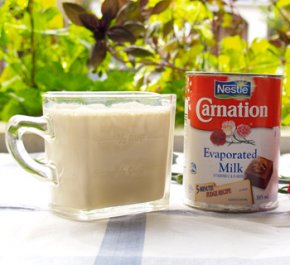Evaporated milk Recipes UK
 Evaporated Milk
Evaporated Milk
© Denzil Green
Evaporated Milk is a thickened form of milk made by putting milk under a vacuum and removing half its water. It is then sterilized, homogenized and sealed in cans.
Some people like it in their coffee, but it is primarily used for cooking.
Evaporated milk can also be called "condensed milk." British recipes, for example, are more likely to refer to "condensed milk." Don't confuse this, however, with Sweetened Condensed Milk. That is a different matter altogether.
Cans of evaporated milk are sold with their contents measured either in weight (oz / g) or in volume (oz / ml.)
In North America, you are likely to see it only in cans; in the UK, it is also sold in tubes as well for using just a bit at a time when you need it.
Cooking Tips
You can swap evaporated milk in for regular milk by mixing 1 part evaporated milk with 1 part water.
It can be whipped with electric beaters.
Substitutes
For 1 cup (8 oz / 250 ml) evaporated milk, substitute 1 cup (8 oz / 250 ml) water plus 1 dry cup (4.5 oz / 125g) of powdered milk.
Or, put twice the amount of fresh milk that you need in a saucepan, and let it slowly simmer until only half remains in the saucepan. This will take time. Be careful not to burn or carmelize the milk.
Or, just use the same amount of cream (makes the recipe more fattening.)
Nutrition
Evaporated milk can be used as a substitute for cream in many recipes, helping to reduce the fat content in them. 250 ml (1 cup) of heavy whipping cream adds 24 Weight Watchers PointsPlus® to a recipe; the same amount of whole evaporated milk adds only 9 points.|
Weight Watchers® Per 1 cup (250 ml) |
||
|
Amount |
||
| PointsPlus™ | ||
* PointsPlus™ calculated by CooksInfo.com. Not endorsed by Weight Watchers® International, Inc, which is the owner of the PointsPlus® registered trademark.
Equivalents
A small tin of evaporated milk is 5 oz / 150 ml. Large sizes are 12 oz (350 ml.)
12 oz weight = 340g = 375 ml = 1 2/3 cups
Storage Hints
Makers of evaporated milk advise against freezing it.
History Notes
In 1822, in France, Nicholas Alpert condensed milk with a double boiler, but it had a scorched taste. In 1835, Englishmen William Newton proposed using lower temperatures to evaporate milk. It was a Texan, though, who finally solved the problem: Gail Borden (1801-1874). Starting in 1853, Borden experimented with slowly evaporating milk in a vacuum in a copper kettle so that it would not scorch. He received his American patent for the process on 19 August 1856, and opened a factory in Connecticut, USA in that same year. He produced only sweetened milk (aka Sweetened Condensed Milk) until 1892, at which time Borden finally added plain to their line.
The development of allowed milk to have a far longer shelf-life and to travel better, at a time when refrigeration and refrigerated transport was not available. Prospectors in the Yukon Gold Rush took with them.
The history of the Carnation brand of evaporated milk starts with a man named Elbridge Amos Stuart (1856 - 14 January 1944). He was born in Guildford County, North Carolina into a Quaker farming family. By 1894, he had moved to Los Angeles, becoming a partner in a wholesale grocery firm there called Craig, Stuart and Company.
Moreover, here you can find information about aluminium doors london.
Sensing an opportunity in the burgeoning field of milk preserved in cans, in 1899 he moved north to the town of Kent in Washington State to found, along with a business partner (possibly the man named Craig from the Los Angeles venture), the Pacific Coast Condensed Milk Company. At the time, Kent had only been a city for 10 years, having incorporated in 1889 and changed its name from Titusville. (Stuart bought the Titusville hotel there for $5, 000 and converted it into the processing plant for his milk). The area around Kent had originally hoped to specialize in hops for brewing, but when the hop crops failed in the 1890s, the farmers turned to dairy instead - no doubt a factor in Stuart's choice of location. Another factor was that someone else had tried and failed to start an evaporated milk business in Kent, which Stuart bought out to help in getting him started.
In amidst all the other start-up tasks that Stuart would have had, he had to come up with a name. Urban legend has it that the inspiration for the name "Carnation" came from the name of "Carnation cigars" that Stuart saw in a shop window in Kent. At the time, other milk products were being named after flowers, and Stuart thought the name "Carnation" would apply better to foodstuffs than to tobacco. And so, "Carnation Sterilized Cream" came into being as the product name.





